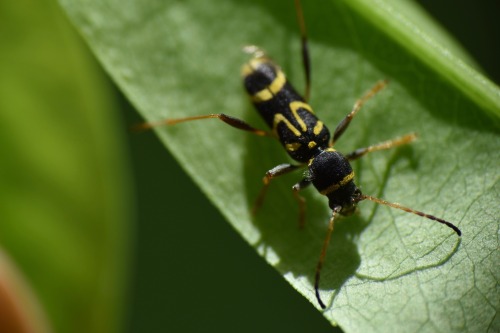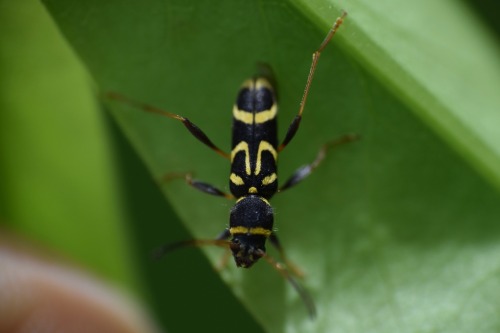Leaf Beetle (Sumitrosis Inaequalis), Taken April 19, 2025, In Georgia, US

Leaf Beetle (Sumitrosis inaequalis), taken April 19, 2025, in Georgia, US
A little leaf beetle! These guys are quite interesting and from afar look like weevils because of their pattern. Adult leaf beetles lay their eggs inside the leaves of host plants. Larvae then hatch and "mine" their way through the interior layers of the leaf, forming a pale, dried trail throughout the leaf. Larvae then pupate and, upon emergence, chew their way out of the leaf and fly away in search of a mate!
More Posts from Northerlyy and Others


American Robin (Turdus migratorius), male, taken February 24, 2025, in Georgia, US
A drinker, I fear... The robins were incredibly bold today, though that isn't unusual for them! This guy allowed me to take some nice pictures and a short video of him before he took off. With the sound on, you can hear the cacophony that is 20 birds screaming and my pond waterfall all layered on top of one another. Be grateful the blackbirds hadn't arrived yet—they're deafening.



Round-necked Longhorn Beetle (Clytus ruricola), taken May 2, 2025, in Georgia, US
A cool longhorn beetle who's slumber I disturbed! This guy was hiding under a leaf after a storm. I didn't recognize the beetle, so I flipped his little leaf over for pictures. He was disturbed but didn't seem afraid, slowly exploring my presence and staying after I left him alone. I'm seeing lots of new longhorn beetles outside, but most of them are so skittish that they fly away as soon as they see me. I just happened to catch this guy at a lucky time!

Eastern Kingbird (Tyrannus tyrannus), taken July 19, 2024, in New Hampshire, US
Looking down at me from above... Though these birds would never get very close, I still find the few pictures I got of them wonderful. This one in particular is very nice! The fact that he perched right in a gap in the branches so he could look at me was pretty fortunate, since it turned into a really cool picture!
Brave Squirrel...



European Starling (Sturnus vulgaris), juvenile, take May 9, 2025, in Georgia, US
A little guy! I've been seeing this young fellow flying around the bird feeders for a few days and was finally able to get some good shots of him. I never see him with any parents, so I have no way of telling if he's a nest parasite or was raised by the local starlings, though the previous year the starlings raised their own babies, so I assume they did this spring as well. He's looking lively and healthy and eats on his own, so he's well on his way to becoming a strong adult!
THANK YOU!!! I am a total noob at cameras, so this is all really really helpful!! I haven't adjusted most of my settings (other than the obvious, like sound and timezone and other basic stuff) other than switching my focus to manual when using the raynox like you suggested—definitely a good tip, I can guess what the camera does when it's on auto lol.
I am certainly feeling the learning curve right now, but I find the increased challenge really rewarding. It also forces me to slow down and spend more time on each individual I photograph, which makes the whole process feel more personal. You said the 70-300mm was wonky when you tried it, but I'm actually enjoying it a lot lol. It allows me to tailor the magnification for each subject I photograph depending on size and produces a higher quality image than my 18-55. After a certain point (~100 or 135mm I think?) flash is inviable with it, though, because the lens starts interfering and causing a shadow, so I have to stick to sunny areas with it if I want to go up to 200mm. I'll have to play around with flash more on both lenses since I think most of the clarity issues I'm having with the 18-55 can be fixed with it, and flash usually makes everything better anyways.
Again I really appreciate these tips!! I'll have to try them out when I go out tomorrow, especially playing with the flash and aperture settings, and see how that changes things!
i am photographing hymenopterans that are smaller and more indistinguishable than you could possibly imagine

Vesper Bluet (Enallagma vesperum), male, taken May 5, 2025, in Georgia, US
I am here once again with a new damselfly! I've actually seen a couple of these since taking this first photo, but none were as nice looking. Like many bluets, females can be differentiated from males by their thicker abdomen that lacks an elongated black segment on the end. As you can see, the last segment on this male's abdomen is black which would signify his sex if he were the same color as a female. Luckily, the males and females of this species are very easy to tell apart, males being bright yellow and females being blue!


Blue Jay (Cyanocitta cristata), taken May 27, 2024, in Georgia, US
Nature's police, fittingly blue-colored! Sometimes the jays will sound the alarm to get everyone to leave the feeders so they get VIP access to all the seeds. Sometimes the jay alarm call is actually a starling, and all of the birds get double-tricked!


Large Lace-border Moth (Scopula limboundata) (Top) and Dot-lined Wave (Idaea tacturata) (Bottom), taken May 20, 2025, in Georgia, US
At a glance, two quite similar looking moths! When put next to each other or under the experienced eye, though, they can be quite easily differentiated. S. limboundata has a creamy overall coloration, while I. tacturata is more white and brown. I. tacturata is also noticeably smaller when they're not cropped to be the same size lol. They do, however, have the same general pattern, even with the same dark dots on each of their wings! You can see, though, that I. tacturata has dots down its abdomen that S. limboundata lacks. Regardless of their similarities and differences, both are very striking moths!
WAUCE BLAST






























(1, 2, 3, 4, 5, 6, 7, 8, 9, 10, 11, 12, 13, 14, 15, 16, 17, 18, 19, 20, 21, 22, 23, 24, 25, 26, 27, 28, 29, 30)
-
 a1-1976 liked this · 1 month ago
a1-1976 liked this · 1 month ago -
 bazookaboi liked this · 2 months ago
bazookaboi liked this · 2 months ago -
 badlyconstructedfromclouds reblogged this · 2 months ago
badlyconstructedfromclouds reblogged this · 2 months ago -
 dinosaursock liked this · 2 months ago
dinosaursock liked this · 2 months ago -
 aardbeiklei liked this · 2 months ago
aardbeiklei liked this · 2 months ago -
 worm98 reblogged this · 2 months ago
worm98 reblogged this · 2 months ago -
 worm98 liked this · 2 months ago
worm98 liked this · 2 months ago -
 buggaboomew reblogged this · 2 months ago
buggaboomew reblogged this · 2 months ago -
 alcnfr liked this · 2 months ago
alcnfr liked this · 2 months ago -
 semiotomatics liked this · 2 months ago
semiotomatics liked this · 2 months ago -
 northerlyy reblogged this · 2 months ago
northerlyy reblogged this · 2 months ago

Wildlife photography of all kinds in no particular chronological order... call me North!All photos posted are taken by me, and everything that appears here is documented on iNaturalist as well.
242 posts